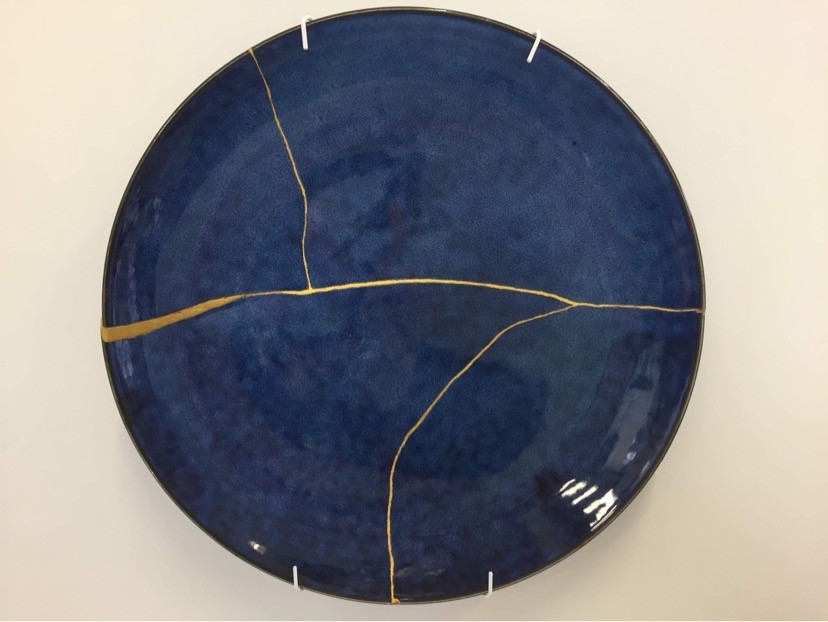“He heals the brokenhearted and binds up their wounds.” Psalm 147:3
The other day I broke my favourite mug. It was a gift from a friend a few years ago. Not only was it a reminder of both the friendship and of Scotland, but it was also the perfect size for my daily mug of coffee. I feel both sad and annoyed with myself for not having been more careful. Right now it is still sitting on my shelf because I can’t quite bring myself to throw it out!
Most Japanese bowls and cups are earthenware, made from clay. A Japanese meal will usually comprise several different items, each in their own bowl or small plate. So a typical household in Japan will have a plethora of small bowls and dishes.
The earthquake and tsunami of 2011 destroyed many houses and their contents, including a large amount of earthenware dishes. One Christian lady was helping to clear out a park in that area and began saving some of the many pieces of broken pottery. She wondered if she could make something beautiful out of all of the devastation around.
The next year she started to gather a group of women to make accessories out of the broken pottery. Some professionals then came to teach them how to make jewellery and the women started to make beautiful necklaces, earrings and other items and sell them worldwide. The Nozomi Project was born (Nozomi means “hope” in Japanese). Not only were the women able to make beautiful accessories out of the broken pottery, but they were also able to earn money doing so, when so many sources of employment in that area had been destroyed.
There is another Japanese way of bringing beauty out of brokenness – the art of ‘kintsugi’. Rather than throwing away a broken plate or bowl, the pieces of pottery are put back together with gold lacquer. In some ways it might seem a strange thing to do – the repair with gold usually costs more than the original item. Also, rather than conceal the break, the lacquer accentuates it. And yet this is the beauty of kintsugi. It embraces the brokenness and highlights the imperfections, and as a result creates something unique and more valuable.
In many ways the art of kintsugi is a reflection of the gospel. In 2 Corinthians 4:7-10 Paul writes: “But we have this treasure in jars of clay to show that this all-surpassing power is from God and not from us. We are hard pressed on every side, but not crushed; perplexed, but not in despair; persecuted, but not abandoned; struck down, but not destroyed. We always carry around in our body the death of Jesus, so that the life of Jesus may also be revealed in our body.”
As we live in this fallen world, we are surrounded by brokenness. We experience brokenness in our own lives too. Jars of clay can crack and break easily. Yet Psalm 147:3 tells us that the Lord “heals the brokenhearted and binds up their wounds”. God is like the master kintsugi artist. When we are broken, he doesn’t toss us aside or get rid of us. Rather, he is close to us and saves us (Psalm 34:16). In his grace he puts the broken pieces back together, and in that process, creates something even more beautiful.
We may feel that the scars which result from our brokenness are an ugly reminder of what was. But in God’s hands those scars can become something precious. Jesus’ resurrected body still bore the scars of His crucifixion in his hands, feet and side. As Matthew Bridges wrote in his well-known hymn, Crown Him With Many Crowns: “behold his hands and side, rich wounds, yet visible above, in beauty glorified”.
Jerry Sittser’s wife, mother, and one of his daughters were killed in an accident with a drunk driver. Three years later, he wrote the book, ‘A Grace Disguised: how the soul grows through loss’. He talks often in the book about the brokenness which resulted from such a tragic loss. Yet, by the end of the book he is able to write:
“The supreme challenge to anyone facing catastrophic loss involves facing the darkness of the loss on the one hand, and learning to live with renewed vitality and gratitude on the other. This challenge is met when we learn to take the loss into ourselves and to be enlarged by it, so that our capacity to live life well and to know God intimately increases…Loss can function as a catalyst to transform us. It can lead us to God, the only One who has the desire and power to give us life.”
Just yesterday I heard a Japanese pastor speak about a time when he was asked to resign from a previous church or be fired. He said that at the time it was the worst thing which had happened in his life, but looking back it was the best thing, because God met him there, challenged him and transformed him.
May we trust that God will be close to us in our brokenness, that He will bind us up by His grace, and in doing so create something even more beautiful.
By Lorna Ferguson


